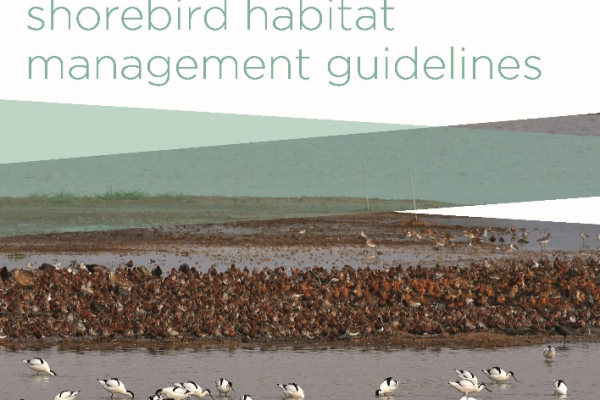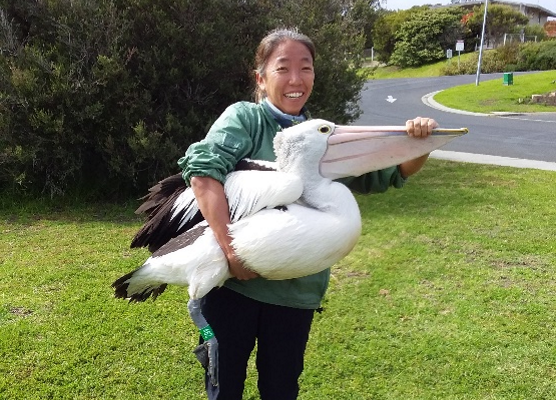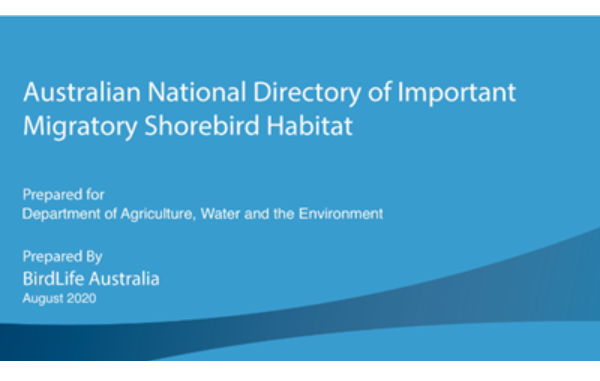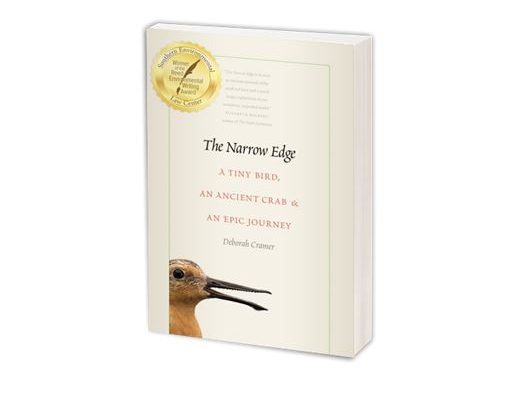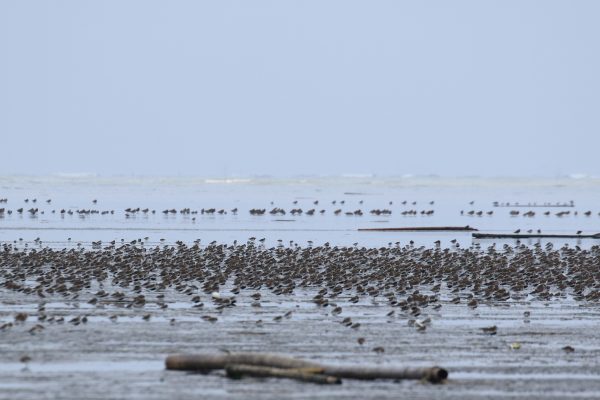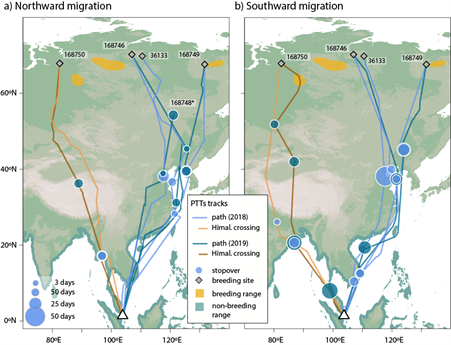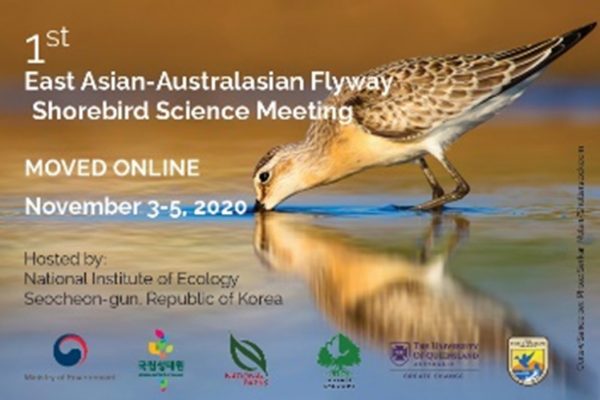-
Coastal high-tide shorebird habitat management guidelines
In recent years there is increasing recognition of the critical importance of intertidal wetlands to conserving biodiversity, including shorebird populations. However, the necessity of roosting sites, especially during high…
Continue reading -
“Flyway: connecting people and migratory waterbirds” story series #12 – Ms. Katherine Leung
If someone asked Katherine Leung what is her work, “Following the migratory waterbirds” may probably her answer. This EAAFP flyway featuring this lady who migrates along the coast of…
Continue reading -
EAAF Shorebird Tracking Group 1st Webinar
The EAAF Shorebird Tracking Group, established in 2021 following the 1st East Asian-Australasian Flyway Shorebird Science Meeting in 2020, held the first webinar on 13th…
Continue reading -
Australia published National Directory of Important Migratory Shorebird Habitat
A National Directory of Important Migratory Shorebird Habitat ('Directory') was newly published by BirdLife Australia and supported by the Australian Government. The Directory identifies, and guides investment into the protection and restoration of, important migratory shorebird habitat around Australia. It builds community awareness and Indigenous knowledge, helps achieve the goals of the Australian Government’s Wildlife Conservation Plan for Migratory Shorebirds and contributes to the implementation of Australia’s international obligations to the conservation and management of migratory shorebirds. It is based on thousands of field surveys by volunteers and experts, millions of bird sightings and uses rigorous methodology to identify key sites, thus providing useful and objective guidance. Habitat is key: Populations of many species of migratory shorebirds have undergone substantial decline over recent and extended periods of time. As an example, numbers of Far Eastern Curlew (Numenius madagascariensis) have declined by more than 80% over the course of by now four decades. Halting this decline and reversing the current trend is without alternative if threatened species are to avoid extinction and continue to contribute as an integral component of Australia nation’s biodiversity to the functioning of Australia’s ecosystems. Actions and processes threatening migratory shorebird habitat have to be effectively recognized and mitigated. In order to achieve this, decision-makers and stakeholders around Australia need to be able to easily access information on the importance of sites for migratory shorebirds. The directory provides this crucial link which was not previously been available. The Directory also provides a starting point for a more comprehensive assessment of the current state of the habitat listed, a prioritization of sites according to current or future threats experienced and more targeted conservation action. This directly addresses and supports some of the priority actions in the Australian Government’s Wildlife Conservation Plan for Migratory Shorebirds across the main objectives: protection of important habitat, anthropogenic threat minimization or elimination and knowledge gap identification. A number of high priority projects are already in the process of being implemented, the Directory makes those more effective and targeted. The Directory is an important step towards effective migratory shorebird habitat protection around Australia. Revision of conservation and management plans for many sites may be necessary to reflect their importance. Specific site action plans detailing conservation measures to be taken for migratory shorebirds at a single site can be developed as a follow-up action. The directory thus also represents a key resource underpinning further conservation measures under Australia’s Conservation Action Plan for Migratory Shorebirds and other frameworks. The Australian Government, which provided gratefully acknowledged funding for this scientific project delivered by BirdLife Australia, has approved of the Directory after consultations with its Committees and all Australian States and Territories. The document has been officially launched on 21 April 2021. It is available for download in *.pdf format in its latest version: National Directory of Important Migratory Shorebird Habitat Download the complete Directory (one file or, due to file size, chapters separately) from the download folder. It is advised to always read the Introduction and Discussion alongside the chapter you need. Overview of chapters: Introduction and Methods Chapter 1 - External Territories Chapter 2 - New South Wales and Australian Capital Territory Chapter 3 - Northern Territory Chapter 4 - Queensland Chapter 5 - South Australia Chapter 6 - Tasmania Chapter 7 - Victoria Chapter 8 - Western Australia Chapter 9 - Species accounts (listing of sites by species, not by site) Discussion and Appendices Due to the large size of the document (1287 pages printed), there are no printed copies are available – please arrange for own printing and binding if desired. If you have feedback on the Directory process or the Directory itself, or you have additional data to contribute to a potential future revision, please write to directory.feedback@birdlife.org.au If you have other questions regarding the Directory, please contact shorebirds@birdlife.org.au For data extractions from BirdLife Australia’s shorebird data holdings, see the Data Extractions section. Repost from BirdLife Australia news article: https://birdlife.org.au/projects/shorebirds/national-directory-ms-habitat (Released on: 21st April, 2021) Know more about Flyway Network Sites in Australia: www.eaaflyway.net/australia/
Continue reading -
New book “THE NARROW EDGE”, by Deborah Cramer, telling the story of Red Knots
Introduction of the book The Narrow Edge Each year tiny sandpipers—Red Knots—undertake a near miraculous 19,000 mile journey from one end of the…
Continue reading -
The southern Jiangsu coast is an important ‘dressing room’ for Spoon-billed Sandpipers and Nordmann’s Greenshanks
If you are lucky to see the Critically Endangered Spoon-billed Sandpipers or Endangered Nordmann’s Greenshanks on the southern Jiangsu coast, they are probably busy gobbling up seafood on the…
Continue reading -
Researchers discover how migratory shorebirds travelling from Southeast Asia cross the Himalayas to breeding grounds in China and Russia
Singapore revealed to be at the intersection of the Central Asian Flyway and East Asian-Australasian Flyway These new insights give researchers, policymakers and conservation biologists a more robust…
Continue reading -
1st East Asian-Australasian Flyway Shorebird Science Meeting Report
Over 400 people from 39 countries/regions registered for the 1st East Asian-Australasian Flyway Shorebird Science Virtual Meeting (EAAFSSM) that took place…
Continue reading -
Indonesian wetland managers gather to share best practices and build a national partnership
Minseon Kim, EAAFP Programme Officer An Indonesian National Training Workshop for Flyway and Ramsar site managers was held in Jakarta on 19-23 September 2016, kindly organised by the…
Continue reading
- 1
- 2

